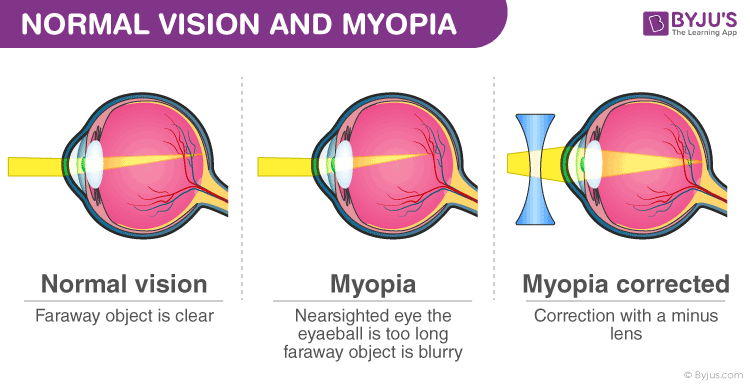Introduction to Eye Defects
Like you may have noticed, the human eyes gradually lose their power of accommodation. In such cases, the person cannot see distinctly and comfortably. There are three common eye defects, and they are(i) myopia or near-sightedness, (ii) Hypermetropia or far-sightedness, and (iii) Presbyopia. These defects are corrected by the use of suitable spherical lenses. In the article, we focus on myopia and its correction.
What is Myopia?
Myopia is also known as near-sightedness or short-sightedness. What happens here is that light rays do not focus on the surface of the retina but in front of it. This results in images being blurry when perceived. In such a case, distant images appear out of focus but objects nearby are seen clearly. This is why myopia is also called near or short-sightedness.
It can occur if the eyeball is elongated leading to image formation in front of the retina. It can also occur if the refracting power of the lens is affected due to the cornea or lens being too curved. This effect can be more pronounced with age. A combination of these effects will also lead to myopia.
Similar Articles
Correcting Myopia
It is important to remember that Myopia is an eye defect and not an eye disease. Therefore, it can be corrected. Since the image is formed in front of the retina, correcting this problem can counter the effects produced due to this.

The above image depicts how the disease can be countered theoretically. It can be done in the following ways.
The treatment of myopia consists of managing both the visual acuity loss and the complications that may arise. Treatment of the blurred vision in myopia has had a long and checkered history. Everything from physical exercise to palming the eyes to having myopic students study in green rooms has been advocated at one time or another.
Sight-saving classes, exercises, under-correction, cycloplegic therapy, contact lenses, pinhole glasses, and many other therapies have been aimed at preventing or slowing the progression of myopia. Surgery has been advocated to retard the progression of staphylomas in pathological myopia. A few of these therapies deserve mention.
Did you know that reading books at close range or watching television at close range can lead to Myopia? This is because the eye gets used to a near focus and adapts to that. If your vision is perfect now, avoid such kinds of habits so that it doesn’t lead to acquired disease. Although this is a defect that can be countered, severe myopia (power above -6) can lead to the detachment of retina which could result in loss of vision.
Watch the video below to learn how and why spectacles/contact lenses are used to correct defects of vision and how exactly they affect the human eye.

Stay tuned with BYJU’S for more such interesting articles. Also, register to “BYJU’S – The Learning App” for loads of interactive, engaging Physics-related videos and an unlimited academic assist.




Comments